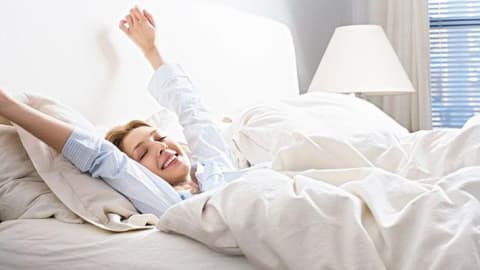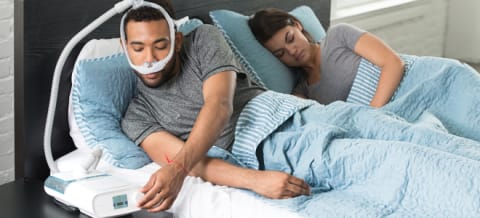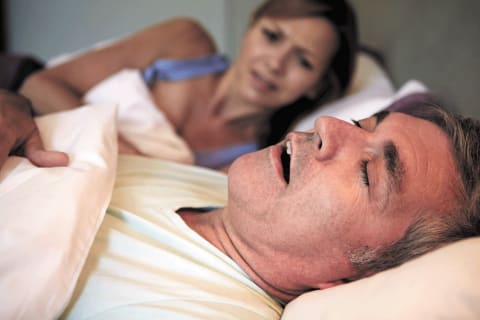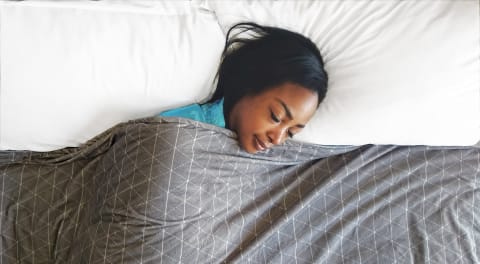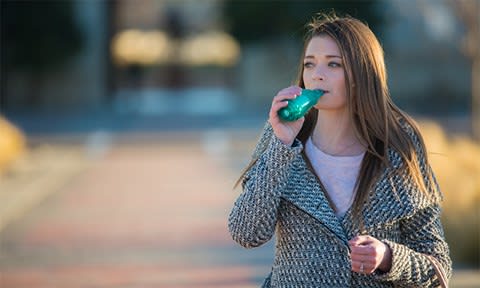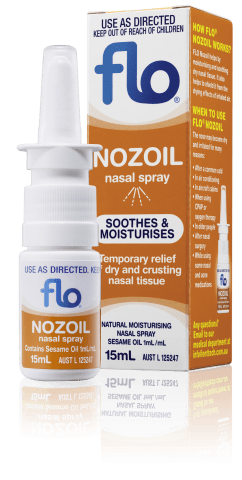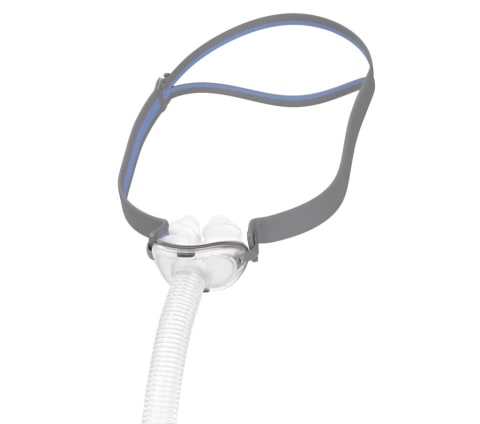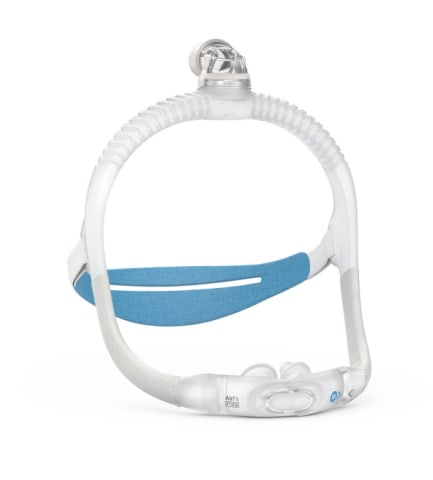Best CPAP Mask For Side Sleepers
Why Sleeping on Your Side Can Complicate Mask Fit and Comfort
Side sleeping has many benefits for those with obstructive sleep apnea — it can reduce airway obstruction, lower snoring, and even improve oxygen levels. But it also presents some unique challenges when it comes to CPAP mask use.
When you sleep on your side, your mask can press into your pillow, which may shift the cushion, break the seal, or cause pressure marks on your skin. Tubing can also get in the way, especially if it exits from the front of your mask and pulls downward as you move. If your mask doesn’t accommodate these factors, you may experience more leaks, noise, or general discomfort — all of which can make therapy feel like a chore.
Choosing a Mask Style That Moves With You — Not Against You
Side sleepers tend to do best with mask styles that are:
- Low-profile and lightweight, to reduce facial pressure
- Flexible and secure, to maintain seal during movement
- Equipped with top-of-head tubing, to reduce hose drag and twisting
For many, nasal pillow masks like the ResMed AirFit P10 are ideal. These sit snugly at the nostrils with virtually no facial contact, making them well-suited to side sleepers who don’t breathe through their mouth. The Fisher & Paykel Evora Nasal Mask is another popular choice, offering a soft, secure cradle design with minimal disruption to sleep posture.
Mouth breathers or those requiring higher pressure may need a full face mask, but that doesn’t mean comfort has to be sacrificed. The ResMed AirFit F30i and Philips DreamWear Full Face Mask both feature tubing that connects at the top of the head and offer under-the-nose cushions that minimise cheek contact — making them much more compatible with side sleeping than traditional, bulkier full face models.
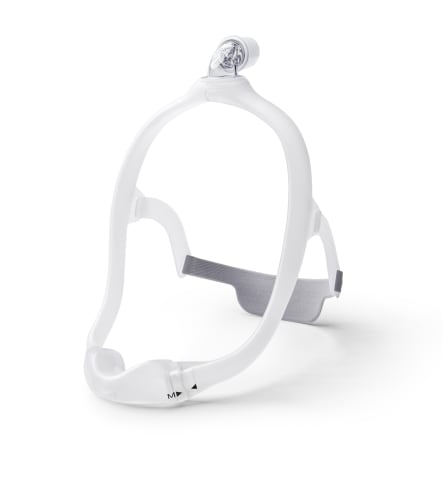 Philips Respironics DreamWear Under the Nose Nasal CPAP Mask
Philips Respironics DreamWear Under the Nose Nasal CPAP Mask
The Importance of Testing Your Mask While Lying Down
Many people try their CPAP masks for the first time while sitting upright — and while that’s helpful for getting familiar with the basics, it doesn’t tell the full story. Side sleepers in particular need to know how their mask behaves under pressure, literally, when lying in bed.
That’s why our team always recommend replicating your sleep position during mask fitting, and will be more than happy to walk you through how to:
- Lie on your side with your mask on and machine running
- Monitor for leaks at the pillow-side cheek
- Test the seal when moving from side to side
- Check whether tubing tugs or pulls with head movement
This real-world testing helps uncover issues that might not show up in a static fitting and ensures you’re not waking up to air leaks or discomfort. We also offer CPAP pillows with contoured cut-outs to accommodate the mask and tubing — a great way to improve seal security and sleep posture at the same time.
How the Right Accessories Can Improve Comfort and Seal
While the mask itself is essential, side sleepers often find that a few simple CPAP accessories can significantly improve therapy comfort and consistency. At Sove, we often recommend the following:
- Contour CPAP pillows: These have dips or cut-outs to reduce mask pressure and maintain a neutral neck position while sleeping on your side.
- Hose lifts or holders: These suspend the tubing above your head or bed, reducing drag and preventing your mask from shifting.
- Mask liners: These fabric barriers sit between your face and the cushion, helping reduce leaks caused by skin oils and improving comfort.
- Headgear pads or strap covers: These soften contact points and help prevent red marks — especially useful for side sleepers who feel the strap on their cheek.
Side Sleeping and CPAP: It’s All About Personal Fit
What works for one side sleeper may not work for another — that’s why personalisation and professional guidance matter. Your facial structure, breathing style, pressure settings, and pillow height all play a role in finding the perfect CPAP mask setup.
Whether you’re brand new to CPAP or just looking for a more comfortable side-sleeper solution, we’ll work with you to find a mask that helps you sleep peacefully — in the position you prefer.
ALWAYS FOLLOW THE DIRECTIONS FOR USE. CPAP is used for Obstructive Sleep Apnoea treatment. When considering whether CPAP is right for you, speak to your doctor. Payment plans available for approved applicants only; fees, terms, conditions, minimum amounts and exclusions apply.
FAQs: CPAP Masks and Side Sleeping
What type of CPAP mask is best for side sleepers?
The best CPAP mask for side sleepers is one that stays secure when your face presses into the pillow, offers a low profile to reduce bulk, and maintains a comfortable, leak-free seal during movement. Many side sleepers do well with nasal pillow masks like the ResMed AirFit P10 — one of the lightest, most minimal masks available. It offers excellent seal retention and doesn’t get in the way when you turn your head.
If you prefer a nasal mask with a bit more support, the Fisher & Paykel Evora is designed with cap-style headgear and a compact frame that remains stable through side-to-side movement.
For side sleepers who need full-face therapy, the ResMed AirFit F30i and Philips DreamWear Full Face are top contenders. Both have tubing that connects at the top of the head (not the front), reducing hose drag and helping you sleep on your side without compromising your therapy.
How important is CPAP mask fit and size for side sleepers?
Fit is absolutely crucial — especially for side sleepers. A mask that fits well while sitting upright might leak when you lie down, particularly if the cushion lifts slightly or your headgear shifts with movement. That’s why side sleepers need masks with flexible cushions, minimal facial bulk, and a secure yet gentle seal.
Our team performs mask fittings in the sleeping position, and we offer take-home trials so you can test fit and comfort in your real sleep environment. Our consultants will ensure you have the right cushion size, adjust headgear to avoid pressure points, and recommend accessories (like pillows or liners) to maximise fit while sleeping on your side.
Should I consult a doctor before choosing a CPAP mask?
Your doctor or sleep physician plays an important role in diagnosing sleep apnea and prescribing the correct therapy pressure. However, when it comes to choosing the right mask style, our Sove CPAP Consultants are highly experienced in working with all mask types and sleeping styles — including side sleepers.
We collaborate with your referring doctor if needed, but our in-house team can guide you through:
- Selecting the right mask type (nasal, nasal pillow, or full face)
- Fitting and adjusting it correctly
- Recommending the best setup for your sleeping position and lifestyle
If you’re just starting therapy or switching masks, you don’t need a new prescription — just expert help from someone who understands the details of side-sleeper comfort.
Are there accessories that help side sleepers use CPAP masks more comfortably?
Yes, and for side sleepers, accessories can be game-changers. At Sove CPAP Clinic, we often recommend:
- Contour CPAP pillows with cut-outs that allow room for your mask to rest without pressure
- Hose lifts or tubing anchors to prevent hose pull or drag when you move
- Mask liners, which cushion your face and help improve seal by absorbing facial oils
- Headgear strap pads, which protect your cheeks from marks and improve overall softness
These additions make a real difference for patients who sleep on their side — helping you stay comfortable, reduce leaks, and wake up with fewer red marks.
Can I use a full-face CPAP mask if I mainly sleep on my side?
Yes, but it’s important to choose the right type of full-face mask. Traditional models can be bulky and prone to leaks when sleeping on your side, but newer designs are much more sleep-position friendly.
The ResMed AirFit F30i, for example, features an under-the-nose cushion and tubing that connects at the top of the head — giving you more flexibility and less facial contact. Similarly, the Philips DreamWear Full Face Mask offers a slim profile and soft frame that allows you to sleep on either side comfortably.
If you’re a side sleeper who breathes through your mouth or needs high pressure, a well-designed full-face mask can absolutely work — and our team at Sove can help you fit and trial one before you commit.
What are the best cleaning and maintenance practices to avoid mask leaks for side sleepers?
Side sleepers often experience leaks due to movement or friction with the pillow — and a clean, well-maintained mask is essential to maintaining a secure seal.
Here are some key tips:
- Clean your mask daily using CPAP-safe wipes or warm water with mild soap. Oils from your skin can break the seal and cause leaks.
- Inspect and replace cushions regularly — typically every 1–3 months — as worn cushions are less effective at holding a seal.
- Check your headgear fit weekly. If straps have stretched or loosened, the mask may shift when you lie on your side.
- Use a mask liner to reduce leaks and provide a more stable seal.
- Avoid overtightening your headgear — this can cause discomfort and still lead to leaks. A proper fit should be snug, not tight.

